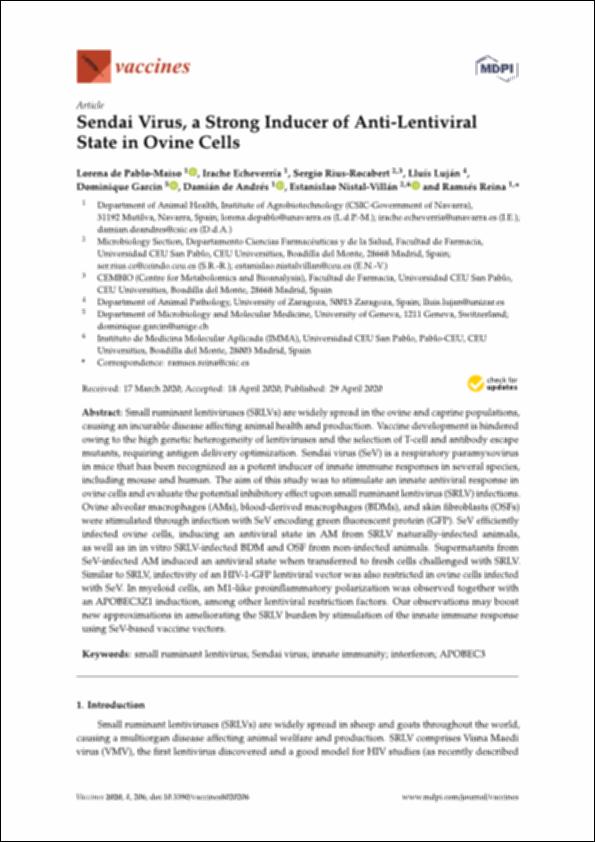Por favor, use este identificador para citar o enlazar este ítem:
http://hdl.handle.net/10637/15306Sendai virus, a strong inducer of anti-lentiviral state in ovine cells
| Título : | Sendai virus, a strong inducer of anti-lentiviral state in ovine cells |
| Autor : | Pablo Maiso, Lorena de Echeverría, Irache Rius Rocabert, Sergio Garcin, Dominique Andrés, Damián de Nistal Villán, Estanislao Ramsés, Reina Luján, Lluís |
| Materias: | Small ruminant lentivirus; Sendai virus; Innate immunity; Interferon; APOBEC3 |
| Editorial : | MDPI |
| Citación : | De Pablo-Maiso, L., Echeverría, I., De Andrés, D., Reina, R., Rius-Rocabert, S., Nistal-Villán, E., Luján, L., & Garcin, D. (2020). Sendai virus, a strong inducer of anti-lentiviral state in ovine cells. Vaccines, 8(2). https://doi.org/10.3390/vaccines8020206 |
| Resumen : | Small ruminant lentiviruses (SRLVs) are widely spread in the ovine and caprine populations, causing an incurable disease a ecting animal health and production. Vaccine development is hindered owing to the high genetic heterogeneity of lentiviruses and the selection of T-cell and antibody escape mutants, requiring antigen delivery optimization. Sendai virus (SeV) is a respiratory paramyxovirus in mice that has been recognized as a potent inducer of innate immune responses in several species, including mouse and human. The aim of this study was to stimulate an innate antiviral response in ovine cells and evaluate the potential inhibitory e ect upon small ruminant lentivirus (SRLV) infections. Ovine alveolar macrophages (AMs), blood-derived macrophages (BDMs), and skin fibroblasts (OSFs) were stimulated through infection with SeV encoding green fluorescent protein (GFP). SeV e ciently infected ovine cells, inducing an antiviral state in AM from SRLV naturally-infected animals, as well as in in vitro SRLV-infected BDM and OSF from non-infected animals. Supernatants from SeV-infected AM induced an antiviral state when transferred to fresh cells challenged with SRLV. Similar to SRLV, infectivity of an HIV-1-GFP lentiviral vector was also restricted in ovine cells infected with SeV. In myeloid cells, an M1-like proinflammatory polarization was observed together with an APOBEC3Z1 induction, among other lentiviral restriction factors. Our observations may boost new approximations in ameliorating the SRLV burden by stimulation of the innate immune response using SeV-based vaccine vectors. |
| URI : | http://hdl.handle.net/10637/15306 |
| Derechos: | http://creativecommons.org/licenses/by-nc-nd/4.0/deed.es |
| ISSN : | 2076-393X |
| Fecha de publicación : | 2020 |
| Centro : | Universidad San Pablo-CEU |
| Aparece en las colecciones: | Facultad de Farmacia |
Los ítems de DSpace están protegidos por copyright, con todos los derechos reservados, a menos que se indique lo contrario.


